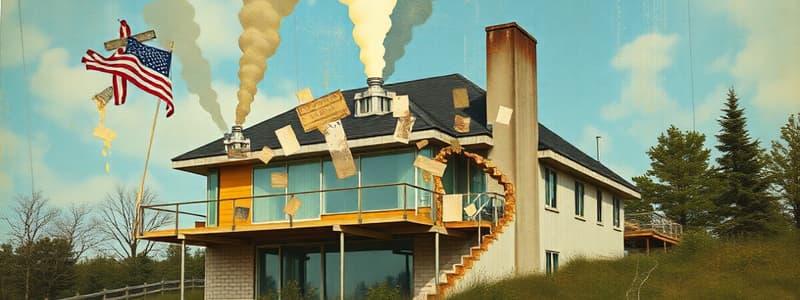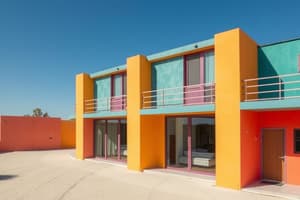Podcast
Questions and Answers
What is the primary benefit of an atrium in building design?
What is the primary benefit of an atrium in building design?
- It serves as an aesthetic focal point.
- It allows hot air to escape at the top. (correct)
- It provides additional structural support.
- It reduces sound transmission within the building.
What is the main function of a light shelf in an architectural setting?
What is the main function of a light shelf in an architectural setting?
- To serve as a decorative feature.
- To reflect daylight deeper into the building. (correct)
- To enhance exterior visibility during night.
- To provide structural stability.
What type of windows are clerestory windows and what is their purpose?
What type of windows are clerestory windows and what is their purpose?
- High, north-facing windows for light and air circulation. (correct)
- Large, tinted windows to reduce glare.
- Small, operable windows for ventilation.
- Ground-level windows for security purposes.
What do light tubes primarily accomplish in a building?
What do light tubes primarily accomplish in a building?
In what way does air movement contribute to comfort in hot-humid environments?
In what way does air movement contribute to comfort in hot-humid environments?
What is the primary principle behind stack ventilation?
What is the primary principle behind stack ventilation?
Which method of passive ventilation focuses on maximizing the use of natural breezes?
Which method of passive ventilation focuses on maximizing the use of natural breezes?
What advantage does passive ventilation have over traditional air conditioning?
What advantage does passive ventilation have over traditional air conditioning?
Which of the following is crucial for the design of passive ventilation systems in buildings?
Which of the following is crucial for the design of passive ventilation systems in buildings?
How does removing hot air from a building help in passive ventilation?
How does removing hot air from a building help in passive ventilation?
Which component is essential for achieving effective passive ventilation?
Which component is essential for achieving effective passive ventilation?
What is the benefit of designing a building to catch breezes by raising it off the ground?
What is the benefit of designing a building to catch breezes by raising it off the ground?
What is meant by 'mixed-mode' use in building design?
What is meant by 'mixed-mode' use in building design?
What is the primary advantage of slanted louvers over parallel louvers?
What is the primary advantage of slanted louvers over parallel louvers?
For which exposure are vertical louvers most effective?
For which exposure are vertical louvers most effective?
What feature do eggcrates offer compared to standard louvers?
What feature do eggcrates offer compared to standard louvers?
What can be a drawback of using louvers?
What can be a drawback of using louvers?
How much reduction in solar radiation can solar blinds and screens potentially provide?
How much reduction in solar radiation can solar blinds and screens potentially provide?
Which of the following is NOT a method to maximize natural lighting in a building?
Which of the following is NOT a method to maximize natural lighting in a building?
What is a common feature of skylights to prevent heat transfer?
What is a common feature of skylights to prevent heat transfer?
What defines an atrium in architectural terms?
What defines an atrium in architectural terms?
What is the primary benefit of louvers and casement style windows?
What is the primary benefit of louvers and casement style windows?
How can well-placed windows contribute to indoor climate control?
How can well-placed windows contribute to indoor climate control?
Which characteristic is essential for windows in a tropical climate?
Which characteristic is essential for windows in a tropical climate?
What is a disadvantage of using reflective coatings on glass?
What is a disadvantage of using reflective coatings on glass?
What is the primary purpose of solar shading devices?
What is the primary purpose of solar shading devices?
Which orientation of horizontal overhangs is most effective for shading?
Which orientation of horizontal overhangs is most effective for shading?
How can louvers help in terms of air circulation?
How can louvers help in terms of air circulation?
What feature of tinted glass is its main advantage?
What feature of tinted glass is its main advantage?
What is the primary function of bulk insulation?
What is the primary function of bulk insulation?
Which of the following materials is NOT classified as bulk insulation?
Which of the following materials is NOT classified as bulk insulation?
How is reflective insulation primarily effective?
How is reflective insulation primarily effective?
What characteristic of glass wool contributes to its thermal insulation properties?
What characteristic of glass wool contributes to its thermal insulation properties?
In which scenario is reflective insulation particularly beneficial?
In which scenario is reflective insulation particularly beneficial?
What type of insulation is primarily made from natural rocks and minerals?
What type of insulation is primarily made from natural rocks and minerals?
Which type of insulation is known to improve the efficiency of air-conditioning by preventing the loss of cool air?
Which type of insulation is known to improve the efficiency of air-conditioning by preventing the loss of cool air?
What is the common composition of reflective insulation?
What is the common composition of reflective insulation?
What are the two main goals of building orientation?
What are the two main goals of building orientation?
What do Azimuth Lines in sun path diagrams represent?
What do Azimuth Lines in sun path diagrams represent?
How do Altitude Lines appear in a sun path diagram?
How do Altitude Lines appear in a sun path diagram?
What do the Date Lines in sun path diagrams illustrate?
What do the Date Lines in sun path diagrams illustrate?
What information do Hour Lines or Analemma provide in a sun path diagram?
What information do Hour Lines or Analemma provide in a sun path diagram?
Which aspect is NOT considered in building orientation?
Which aspect is NOT considered in building orientation?
Which term refers to angles that run around the edge of a sun path diagram?
Which term refers to angles that run around the edge of a sun path diagram?
The purpose of sun path diagrams primarily includes which of the following?
The purpose of sun path diagrams primarily includes which of the following?
Flashcards
Convection Rule
Convection Rule
Warm air rises and cool air sinks, this natural process drives air circulation.
Ventilation
Ventilation
The process of replacing stale air with fresh air, improving air quality.
Stack Ventilation
Stack Ventilation
Uses convection to naturally induce airflow. Warmer air rises and exits at a higher point, drawing cool air in from below.
Passive Ventilation Design
Passive Ventilation Design
Signup and view all the flashcards
Maximizing Breezes
Maximizing Breezes
Signup and view all the flashcards
Removing Hot Air
Removing Hot Air
Signup and view all the flashcards
Mixed-Mode Building
Mixed-Mode Building
Signup and view all the flashcards
Passive Ventilation Methods
Passive Ventilation Methods
Signup and view all the flashcards
Building Orientation
Building Orientation
Signup and view all the flashcards
Orientation for Minimal Solar Heat Gain
Orientation for Minimal Solar Heat Gain
Signup and view all the flashcards
Orientation for Maximum Airflow
Orientation for Maximum Airflow
Signup and view all the flashcards
Sun Chart
Sun Chart
Signup and view all the flashcards
Azimuth Lines
Azimuth Lines
Signup and view all the flashcards
Altitude Lines
Altitude Lines
Signup and view all the flashcards
Date Lines
Date Lines
Signup and view all the flashcards
Hour Lines/Analemma
Hour Lines/Analemma
Signup and view all the flashcards
Atrium Advantage
Atrium Advantage
Signup and view all the flashcards
Light Shelf Function
Light Shelf Function
Signup and view all the flashcards
Clerestory Window Purpose
Clerestory Window Purpose
Signup and view all the flashcards
Light Tube Function
Light Tube Function
Signup and view all the flashcards
Air Movement's Role
Air Movement's Role
Signup and view all the flashcards
Bulk Insulation
Bulk Insulation
Signup and view all the flashcards
Reflective Insulation
Reflective Insulation
Signup and view all the flashcards
Rock Wool Insulation
Rock Wool Insulation
Signup and view all the flashcards
Glass Wool Insulation
Glass Wool Insulation
Signup and view all the flashcards
How does reflective insulation work?
How does reflective insulation work?
Signup and view all the flashcards
Why is reflective insulation effective in the tropics?
Why is reflective insulation effective in the tropics?
Signup and view all the flashcards
Why is bulk insulation better for cool air retention?
Why is bulk insulation better for cool air retention?
Signup and view all the flashcards
Louvered Windows and Casement Style
Louvered Windows and Casement Style
Signup and view all the flashcards
Convection Air Flow for Buildings
Convection Air Flow for Buildings
Signup and view all the flashcards
What is the purpose of an air layer with reflective insulation?
What is the purpose of an air layer with reflective insulation?
Signup and view all the flashcards
Tropical Climate Windows
Tropical Climate Windows
Signup and view all the flashcards
Tinted Glass
Tinted Glass
Signup and view all the flashcards
Reflective Coatings
Reflective Coatings
Signup and view all the flashcards
Solar Shading
Solar Shading
Signup and view all the flashcards
Horizontal Overhangs
Horizontal Overhangs
Signup and view all the flashcards
Louvers for Air Flow
Louvers for Air Flow
Signup and view all the flashcards
Slanted Louvers
Slanted Louvers
Signup and view all the flashcards
Vertical Louvers
Vertical Louvers
Signup and view all the flashcards
Eggcrates
Eggcrates
Signup and view all the flashcards
Solar Blinds and Screens
Solar Blinds and Screens
Signup and view all the flashcards
Heat-Absorbing Glass
Heat-Absorbing Glass
Signup and view all the flashcards
Natural Lighting Strategy
Natural Lighting Strategy
Signup and view all the flashcards
Skylight
Skylight
Signup and view all the flashcards
Atrium
Atrium
Signup and view all the flashcards
Study Notes
Architecture Tropical Design Module 4
- Module 4, Architecture Tropical Design, delivered by Ar. Angel Clyde G. Manuel, UAP, on 05/12/2024.
Theories and Principles of Tropical Design
- This section covers the theories and principles of tropical design.
Basics of Passive Design
- This module discusses strategies to design buildings that require less reliance on heating and cooling systems.
Goals for Various Climates
- Cold Climate: Maximum thermal retention, maximum heat gain, maximum wind resistance.
- Temperate Climate: Moderate thermal retention, moderate heat gain, slight wind exposure control/humidity control.
- Hot-Humid Climate: Maximum wind exposure, maximum internal airflow, minimum heat gain.
- Hot-Arid Climate: Minimum heat gain, moderate wind resistance, moderate internal airflow.
Passive Design Considerations
- Avoid Heat Gain: Orient buildings to reduce exposure to midday sun, especially during summer. Use materials with low thermal mass. Shade walls and windows, particularly those with high thermal mass. Use glazing on windows that cannot be effectively shaded. Use insulation, light colors, and heat-reflective surfaces.
- Encourage Natural Ventilation: Orient the building and windows towards prevailing winds. Include operable windows and ceiling vents that enable the building to naturally ventilate.
- Make use of Natural Light: Install shaded windows, install shaded skylights, and other natural lighting devices to reduce energy use.
- Create Cool Outdoor Areas: Use verandas and deep balconies, use landscaping to provide shade without blocking cooling breezes. Use planting to reduce ground temperature and minimize reflected heat.
- Low Thermal Mass: Materials like wood, insulation materials, lightweight concrete, plastics, gypsum board.
- High Thermal Mass: Materials like brick, concrete, stone, thermal mass floor system, adobe, rammed earth.
Principles of Passive Design
- Avoid heat gain.
- Encourage natural ventilation.
- Make use of natural light.
- Create cool outdoor areas
Passive Ventilation Methods
- Maximizing breezes: Orient the building to maximize prevailing winds, align vents, windows, and doors, minimize internal obstacles, raise the building off the ground.
- Removing hot air: Design the building to allow hot air to rise and escape. Use window openings across a space from high ones to aid convection.
- Mixed-mode design: Allow natural ventilation in cooler months and energy-efficient air conditioning in hotter months.
- Low thermal mass materials in mixed-mode buildings, if well-insulated.
Landscaping
- Hard surfaces absorb and re-radiate heat, creating a hotter microclimate. Minimizing paving and incorporating vegetation reduces this effect.
- Planting areas around the building creates a cooler environment due to plants' transpiration and moisture loss. External temperatures can be reduced by vegetation.
Thermal Mass
- Thermal mass is the ability of building materials to absorb, store, and release heat.
Insulation
- Insulation controls the rate at which a building loses or gains heat.
- Bulk insulation resists heat transfer and includes materials like mineral wool, cellulose fiber, polyester, and polystyrene.
- Reflective insulation is highly effective at preventing heat gain and reducing the need for air-conditioning, suitable for the tropics.
R-Value
- Insulation materials are given an R-value, which measures resistance to heat flow and indicates effectiveness.
- Higher R-values mean greater insulating effect.
- R-values are additive, combining values of different materials.
U-Value
- U-value is the heat transfer coefficient of an assembly, reciprocal of the total R-value.
Windows
- Encourage air flow.
- Louvers and casement-style windows allow building users to control airflow.
- Well-placed louvers or windows at different levels of the building promote convection and breezes. Design for shading from direct sunlight and proper air flow.
Solar Shading
- Shading devices reduce solar heat gain and glare.
- Types include horizontal overhangs, horizontal louvers, and slanted louvers.
Natural Lighting
- Maximizing natural light reduces the need for artificial lighting.
- Techniques include skylights, atria, light shelves, clerestory windows, and light tubes.
Air Movement
- Essential for passively-cooled environments, particularly in hot-humid localities.
- Air movement generates a cooling sensation due to sweat evaporation.
- Consider building geometry and orientation to enhance air flow.
- Principles of air flow: Air flows from high to low pressure, objects in motion tend to stay in motion, and air flows through pathways of least resistance.
Sea and Land Breeze
- Sea breeze: Wind from the sea (high pressure) toward land (low pressure) during daytime.
- Land breeze: Wind from land (high pressure) toward sea (low pressure) during nighttime.
Tropical Architecture
- Emphasizes green building design for optimal energy efficiency, particularly cooling and reducing building heat gain.
- Main objectives in hot and humid climates include minimizing humidity, maximizing filtered air movement, utilizing maximum shade, creating a cool and dark microclimate, and arranging vegetation effectively.
- Case studies of traditional tropical architecture, such as the Bahay Kubo and Bahay na Bato, highlight principles and practices for optimal thermal comfort and efficiency.
Studying That Suits You
Use AI to generate personalized quizzes and flashcards to suit your learning preferences.




